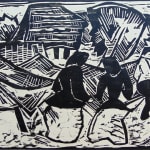



KARL SCHMIDT-ROTTLUFF German, 1884-1976
By the Nets | Bei den Netzen, 1914
Original Hand Signed Woodcut on Laid Paper
51.2 x 62.4 cm. / 20.2 x 24.6 in.
This original woodcut is hand signed in pencil by the artist "S. Rottluff" at the lower right margin.
This is the fifth woodcut of the portfolio "Zehn Holzschnitte von Schmidt-Rottluff" [Ten Woodcuts by Schmidt-Rottluff] that was published in 1919.
It was published by Graphisches Kabinett J. B. Neumann, Berlin in a limited unnumbered edition of 75 plus some proofs.
The printer was Fritz Voigt, Berlin.
Other impressions of this work can be found in the collection of the Museum of Modern Art (MOMA), New York and the de Young Fine Art Museums, San Francisco.
Note:
It was in 1905, whilst in Dresden and enrolled on an architecture course that Karl Schmidt-Rottluff began to experiment with the woodcut technique. The technique itself is synonymous with Germanic artistic traditions. The tactile essence and fragility of the medium as well as the reductive nature of carving in relief was likely a habitual calm for the artist’s nerves during his time on the Eastern front and following his return to Berlin. Whilst the material may be soft and conquerable, the stark black inked images are robust, sharp and dominant. The artist’s own response to the war can be seen clearly even in mundane scenes of civilian life. Schmidt-Rottluff proclaimed, “I really feel pressure to create something that is as strong as possible. The war has really swept away everything from the past.” His woodcuts embody this resilient spirit.
Literature: Schapire, R. & Rathenau, E. (1987). Karl Schmidt-Rottluff: Das Graphische Werk Bis 1923. Berlin: Vormals Euphorion Verlag.
Reference: Schapire 165.
Condition: Very good condition. Some tape remains, verso.
This is the fifth woodcut of the portfolio "Zehn Holzschnitte von Schmidt-Rottluff" [Ten Woodcuts by Schmidt-Rottluff] that was published in 1919.
It was published by Graphisches Kabinett J. B. Neumann, Berlin in a limited unnumbered edition of 75 plus some proofs.
The printer was Fritz Voigt, Berlin.
Other impressions of this work can be found in the collection of the Museum of Modern Art (MOMA), New York and the de Young Fine Art Museums, San Francisco.
Note:
It was in 1905, whilst in Dresden and enrolled on an architecture course that Karl Schmidt-Rottluff began to experiment with the woodcut technique. The technique itself is synonymous with Germanic artistic traditions. The tactile essence and fragility of the medium as well as the reductive nature of carving in relief was likely a habitual calm for the artist’s nerves during his time on the Eastern front and following his return to Berlin. Whilst the material may be soft and conquerable, the stark black inked images are robust, sharp and dominant. The artist’s own response to the war can be seen clearly even in mundane scenes of civilian life. Schmidt-Rottluff proclaimed, “I really feel pressure to create something that is as strong as possible. The war has really swept away everything from the past.” His woodcuts embody this resilient spirit.
Literature: Schapire, R. & Rathenau, E. (1987). Karl Schmidt-Rottluff: Das Graphische Werk Bis 1923. Berlin: Vormals Euphorion Verlag.
Reference: Schapire 165.
Condition: Very good condition. Some tape remains, verso.
$ 17,000.00
Further images
I
I
1
of
3




